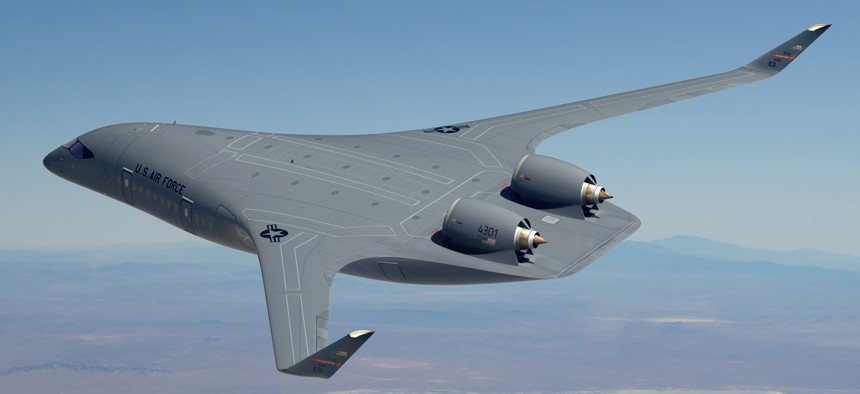
Rendering of the blended-wing body prototype aircraft. U.S. Air Force
Air Force selects JetZero for blended-wing body prototype plane
The company says the airplane will have its first flight in 2027.
The U.S. Air Force has chosen California startup JetZero to build and test a wing-shaped airplane, which may influence the design of the service’s future mobility planes.
The service announced the winner of a Defense Innovation Unit-led competition for a blended-wing body prototype on Tuesday at an Air & Space Forces Association event.
“This is a prototype demonstration project that's intended to accelerate the next generation of what may be the large aircraft fleet that the Air Force needs in the future. It's a streamlined design, different significantly from traditional tube and wing design, and it will improve aerodynamic efficiency and mission capability,” said Air Force Secretary Frank Kendall.
JetZero said in April it was partnering with Northrop Grumman on a blended-wing tanker design, called Z-5, which could position the company to build the Air Force’s future aerial refueler, NGAS, and its next-gen airlifter, NGAL.
However, the JetZero prototype is just a “demonstrator,” and shouldn’t be linked directly to NGAS or NGAL, said Maj. Gen. Albert Miller, Air Mobility Command’s director of strategy, plans, requirements, and programs.
“There's no presumption, right, that this is necessarily the answer for NGAS, but we think that it could be informative in this process,” Miller said. “We are not even to the [analysis of alternatives] stage for NGAS so it would be very premature to say that this is the NGAS solution.”
The Air Force is considering a blended-wing design for future aircraft because it’s much more fuel efficient than traditional airframes. The JetZero offering is estimated to carry twice the fuel of a Boeing KC-46 tanker.
Fuel efficiency is needed in the Indo-Pacific, as “operational energy will be the margin of victory in a near-peer conflict,” said Ravi Chaudhary, assistant Air Force secretary for energy, installations, and environment.
“This is about getting back to basics with what airpower delivers for the joint fight: speed, range, endurance and flexibility, but it's also about efficiency, because in the Indo-Pacific, we expend a little more gas, we need a little more efficiency, the distances a little bit longer,” Chaudhary said.
A blended-wing body aircraft can operate for longer distances and land on shorter runaways, making it more lethal and maneuverable for Air Mobility Command and the joint force, Miller said.
“It is the capability of being able to land someplace on a much shorter runway and pick up a casualty and fly them back to the care that they need. It is the capability of being able to get the same offload of fuel to a critical receiver when and where they need it, maybe from a greater distance because we've seen this in the past where the tanker fleets get pushed back so that the kinetic force can be pushed forward,” Miller said.
JetZero will receive $235 million over the next four years to build and test the prototype—with plans for a first flight in 2027.


